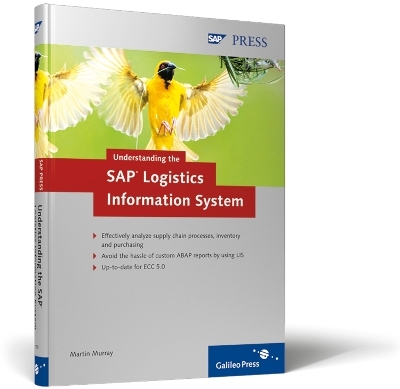
Understanding the SAP Logistics Information System
SAP Press (Verlag)
978-1-59229-108-3 (ISBN)
- Titel ist leider vergriffen;
keine Neuauflage - Artikel merken
From learning about information structures to performing standard and flexible analyses, this book gives you valuable insight and information about the workings of the SAP Logistics Information System (LIS). Without the need for custom ABAP reports, learn how you can produce and run accurate and relevant reports, saving both valuable time and resources. Learn to configure LIS properly and understand how changes in configuration can impact reports. Analyze your supply chain processes, inventory, purchasing efficiently and with ease. Learn how to collect, consolidate, and utilize data from SAP by using LIS. If you are looking to efficiently manage your data and produce useful reports, this book is for you. Packed with the author's insight and experience, this detailed reference book helped you hit the ground running with this invaluable though often under-utilized tool.
A native of London, England, Martin Murray joined the computer industry upon his graduation from Middlesex University in 1986. In 1991, he began working with SAP R/2 in the Materials Management area for a London-based multi-national beverage company. In 1994, he moved to the United States to work as an SAP R/3 consultant. Since then, he's been implementing the Materials Management (MM) and Warehouse Management (WM) functionality in projects throughout the world. He works for IBM Global Business Services.Martin is the author of six best-selling books from SAP PRESS: Materials Management with SAP ERP, Warehouse Management with SAP ERP, Discover Logistics with SAP ERP, Maximize Your Warehouse Operations with SAP ERP, Understanding the SAP Logistics Information System, and SAP Transaction Codes: Your Quick Reference to T-Codes in SAP ERP.
1. Introduction to the Logistics Information System ... 17 ... 1.1 Logistics Information System Overview ... 18 ... 1.2 Components of the Logistics Information System ... 21 ... 1.3 Summary ... 26 2. Information Structures ... 27 ... 2.1 Standard Information Structures ... 27 ... 2.2 User-Defined Information Structures ... 31 ... 2.3 Summary ... 42 3. Standard Analyses ... 43 ... 3.1 Basic Analyses ... 43 ... 3.2 Standard Analyses for Purchasing ... 45 ... 3.3 Standard Analyses for Inventory Controlling ... 52 ... 3.4 Standard Analyses for Production ... 61 ... 3.5 Standard Analyses for Plant Maintenance ... 68 ... 3.6 Standard Analyses for Quality Management ... 72 ... 3.7 Summary ... 75 4. Selection Versions ... 77 ... 4.1 Create a Selection Version ... 77 ... 4.2 Change a Selection Version ... 82 ... 4.3 General Overview of Selection Versions ... 84 ... 4.4 Summary ... 86 5. Drilldown ... 87 ... 5.1 Characteristic Drilldown ... 87 ... 5.3 Switching Information Structures ... 93 ... 5.4 Selection Log ... 95 ... 5.5 Summary ... 96 6. ABC Analysis ... 97 ... 6.1 Create an ABC Analysis ... 97 ... 6.2 Summary ... 102 7. Classification Functionality ... 103 ... 7.1 Graphical Display of Classification ... 104 ... 7.2 Dual Classification Functionality ... 108 ... 7.3 Graphical Display of Dual Classification ... 109 ... 7.4 Summary ... 111 8. Flexible Analysis ... 113 ... 8.1 Overview of Flexible Analysis ... 113 ... 8.2 Evaluation Structures ... 114 ... 8.3 Evaluations ... 115 ... 8.4 Summary ... 116 9. Evaluation Structure ... 117 ... 9.1 Create an Evaluation Structure ... 117 ... 9.2 Change an Evaluation Structure ... 125 ... 9.3 Combining Data ... 129 ... 9.4 Summary ... 130 10. Evaluations ... 131 ... 10.1 Create an Evaluation ... 131 ... 10.2 Change an Evaluation ... 143 ... 10.3 Deleting an Evaluation ... 146 ... 10.4 Create a Set ... 147 ... 10.5 Summary ... 151 11. Hierarchies ... 153 ... 11.1 Example of a Hierarchy ...153 ... 11.2 Creating a Hierarchy ... 154 ... 11.3 Hierarchy Validity Dates ... 159 ... 11.4 Using the Hierarchy ... 161 ... 11.5 Changing a Hierarchy ... 165 ... 11.6 Summary ... 167 12. Sales Information System ... 169 ... 12.1 Information Structures ... 170 ... 12.2 Standard Analyses ... 170 ... 12.3 Configuration for SIS ... 181 ... 12.4 Testing the SIS Updates ... 187 ... 12.5 Summary ... 190 13. Purchasing Information System ... 191 ... 13.1 Information Structures ... 192 ... 13.2 Standard Analyses ... 195 ... 13.3 Long-Term Planning ... 196 ... 13.4 Summary ... 207 14. Inventory Controlling ... 209 ... 14.1 Information Structures ... 209 ... 14.2 Basic Standard Analyses ... 210 ... 14.3 Material Groupings Standard Analyses ... 216 ... 14.4 Parameter Controlling ... 223 ... 14.5 Stock/Requirements ... 226 ... 14.6 Warehouse Management ... 229 ... 14.7 Summary ... 235 15. Shop Floor Information System ... 237 ... 15.1 Information Structures ... 237 ... 15.2 Standard Analyses ... 239 ... 15.3 Repetitive Manufacturing ... 250 ... 15.4 Kanban ... 255 ... 15.5 Summary ... 257 16. Plant Maintenance Information System ... 259 ... 16.1 Information Structures ... 259 ... 16.2 Standard Analyses ... 260 ... 16.3 Summary ... 272 17. Quality Management Information System ... 273 ... 17.1 Information Structures ... 274 ... 17.2 Standard Analyses for Materials ... 275 ... 17.3 Standard Analyses for Vendors ... 285 ... 17.4 Standard Analyses for Customers ... 285 ... 17.5 Summary ... 286 18. Early Warning System ... 287 ... 18.1 Creating an Exception ... 287 ... 18.2 Executing the Exception ... 294 ... 18.3 Exception Groups ... 295 ... 18.4 Periodic Analysis ... 297 ... 18.5 Executing the Exception ... 301 ... 18.6 Summary ... 302 19. Logistics Information Library ... 303 ... 19.1 Retrieving Key Figures ... 303 ... 19.2 Adding Key Figures to the LIL ... 309 ... 19.3 Adding Info Sets to the LIL ... 311 ... 19.4 Summary ... 315 ... 19.5 Book Conclusion ... 315 A Glossary ... 319 B Bibliography ... 321 C The Author ... 323 Acknowledgments ... 323 Index ... 325
| Erscheint lt. Verlag | 1.2.2007 |
|---|---|
| Verlagsort | Maryland |
| Sprache | englisch |
| Maße | 180 x 230 mm |
| Einbandart | gebunden |
| Themenwelt | Informatik ► Weitere Themen ► SAP |
| Wirtschaft ► Betriebswirtschaft / Management | |
| ISBN-10 | 1-59229-108-2 / 1592291082 |
| ISBN-13 | 978-1-59229-108-3 / 9781592291083 |
| Zustand | Neuware |
| Informationen gemäß Produktsicherheitsverordnung (GPSR) | |
| Haben Sie eine Frage zum Produkt? |
aus dem Bereich


